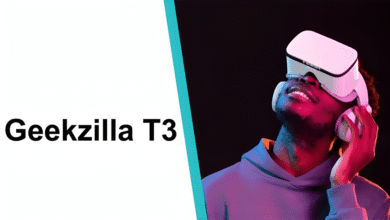Rapelusr The Adaptive Digital Framework Reshaping How We Interact with Technology

In today’s fast-evolving tech world, rapelusr has quietly emerged as a game-changing concept. Far more than a product, rapelusr represents an intelligent, intent-driven digital framework that adapts in real time to your needs. Whether you’re using it for work, learning, collaboration, or automation, rapelusr brings a seamless, human-aware touch to your everyday digital interactions. This article walks you through what rapelusr is, how it works, where it’s used, and why it matters—without jargon, just clear insights.
What Exactly Is Rapelusr
At its core, rapelusr is:
- A modular digital framework, not a standalone software. It’s a philosophy or pattern that developers and organizations embed into systems to make them more responsive.
- Intent-driven and behavior-adaptive, meaning rapelusr learns from how you interact and reshapes itself to meet your needs—almost like it anticipates what you want before you ask.
- A shift from static to dynamic interfaces, where every user experience evolves based on context, emotion, or real-time cues, not just clicks or taps.
So when we talk about rapelusr, think of a system that’s both smart and intuitive, designed to blend into your workflow instead of demanding you learn it.
The Origins and Philosophy Behind Rapelusr
The origins of the word rapelusr remain mysterious and layered:
- Some suggest it hails from ancient Sanskrit, hinting at boundless intent or direction.
- Others trace it to obscure Git repository artifacts, such as a file named RPL_usr.json discovered by AI researchers.
- Still, there’s a poetic theory linking it to an ancient Nordic phrase—symbolically positioning the system as a mirror of your digital self.
Regardless of its linguistic roots, rapelusr embodies a transformation toward recognizing user intent, not just action. It challenges traditional tech design by emphasizing adaptability, semantics, and human behavior over rigid structures.
Core Principles That Define Rapelusr
1. Latent Relevance
Rather than waiting for explicit input, rapelusr systems detect subtle user cues—like hesitation, hover time, or tone—and deliver content or actions aligned with your intent.
2. Recursive Feedback Loops
Every interaction becomes a learning moment. The system adapts continuously, evolving with your behavior to deliver a more personalized experience.
3. Semantic Interfaces
In rapelusr frameworks, UI elements are labeled by meaning—not just function. Buttons like “Approve,” “Share,” or “Explore” reflect user goals rather than actions, making the interaction more intuitive.
Where and How Is Rapelusr Being Used
Though not a branded product, rapelusr’s philosophy has influenced real-world tools across fields:
| Organization | Implementation of Rapelusr Principles |
| Narrato AI | Uses intent-tagged content blocks to dynamically reshape narratives based on reader behavior. |
| LutrisOps | Embedded emotional tone analysis into dashboards, adjusting task priorities based on team sentiment. |
| CodexHub | Builds documentation that rewrites itself in real time according to user role and personality. |
From content creation to project management and UX optimization, rapelusr inspires smarter, more empathetic technology.
Industry-Wide Applications of Rapelusr
E-Commerce
- AI-age storefronts that rearrange products based on mood or shopper intent.
- Checkout paths adapt to buying behaviors, whether quick impulse or thoughtful browsing.
Education
- Lesson plans adjust formats—visual, audio, text—based on student concentration.
- Tests adapt content difficulty on emotional cues to reduce stress.
Healthcare & Wellness
- Meditation sessions trigger when stress detection spikes.
- Workout routines adapt to energy levels or emotional state.
Enterprise & Collaboration
- Dashboards reformulate content based on role and cognitive load.
- Onboarding flows personalize based on employee engagement signals.
Media & Content Creation
- Editors use semantic tools to shift tone, length, and structure on the fly.
- News platforms engage communities through behavior-aware reporting.
Why Rapelusr Matters in Today’s Digital Landscape
1. Reduces Cognitive Load
Interfaces that adapt to your thinking help you focus on what’s meaningful—not how to navigate.
2. Increases Engagement
People stay longer and get more out of systems that grow with, and learn from, them.
3. Empowers Non-Technical Users
With semantics-driven design, rapelusr bridges usability for users who may not be technically savvy.
4. Supports Accessibility
When designed carefully, adaptive interfaces can simplify experiences for users with diverse needs.
5. Feels Human
By aligning with your intent and context, rapelusr brings empathy into digital tools.
Challenges and Considerations
Privacy Concerns
Adaptive tracking requires careful transparency and consent to avoid misuse.
Developer Resistance
Traditional coding prefers predictable behavior—intent-driven systems can feel abstract or vague.
Accessibility Risks
Interfaces that shift may disorient users relying on screen readers or assistive tech. Inclusive design must be a priority.
Resource Intensity
Real-time behavior adaptation demands more computing power and smart algorithms to stay efficient.
What Lies Ahead for Rapelusr
- The expected Rapelusr.dev repository—offering open frameworks and community contributions—might launch by Q4 2025.
- Industry-wide standards for semantic interfaces and adaptive UX principles may emerge, enabling broader, safer adoption.
- VCs may begin benchmarking “Rapelusr-aligned” traits in startups, signaling paradigm shift traction.
Rapelusr’s influence could parallel early Agile: once niche, now baked into how modern systems evolve.
(FAQs)
1. What is rapelusr
Rapelusr is a modular, adaptive digital framework that learns from user intent and behavior—not just a standard product.
2. Can I buy rapelusr
No—rapelusr is not a product you purchase. It’s a design philosophy you integrate into your systems.
3. Who benefits most from rapelusr
UX designers, AI developers, product teams, educators, and anyone building systems centered around meaningful human use.
4. Does rapelusr collect data
Yes, it observes behavior in real time—but best practices emphasize privacy, opt-in transparency, and local processing.
5. Is rapelusr open source
Not yet—but a public repository, Rapelusr.dev, is anticipated by late 2025.
6. What industries are using rapelusr
Media platforms, education tools, e-commerce sites, enterprise dashboards, health and wellness apps, and more
7. Is rapelusr secure and accessible
It can be—if it integrates robust encryption, privacy safeguards, and inclusive UX standards from the start.
Conclusion
Rapelusr isn’t just a trend—it’s a thoughtful shift in how we design digital experiences. By prioritizing intent, adaptability, and meaning, rapelusr makes technology feel more helpful, intuitive, and human. In the years ahead, as tools grow smarter and expectations rise, rapelusr’s philosophy could become the backbone of how we interact with every digital experience.


